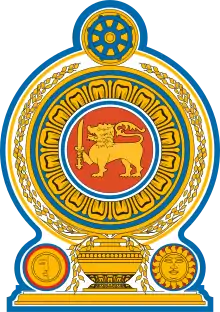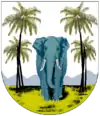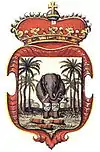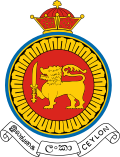Emblem of Sri Lanka
The national emblem of Sri Lanka[1][2][3] is used by the State of Sri Lanka and the Sri Lankan government in connection with the administration and government of the country. The current emblem has been in use since 1972 and created under the ideas and guidance of Nissanka Wijeyeratne. At the time, he was Permanent Secretary to the Ministry of Cultural Affairs and Chairman of the National Emblem and Flag Design Committee.[4] The designer of the emblem was Venerable Mapalagama Wipulasara Maha Thera,[5][6] [7][8][9][10][11][12] [13] and the artwork was by S. M. Seneviratne.
| Emblem of Sri Lanka | |
|---|---|
 | |
| Armiger | Democratic Socialist Republic of Sri Lanka |
| Adopted | 1972 |
| Crest | A Dharmachakra azure on a bezant |
| Blazon | On a circular shield: Maroon, a lion passant Or bearing a Sri Lankan sword Or in its right forepaw; an orle enhanced azure bearing concentrically from the center outwards two annulets argent, the petals of a golden water lily proper, and an annulet Or; a bordure Or |
| Supporters | Golden symbols of the Sun and the Moon; the stalks of rice growing from the vase surrounding the shield |
| Compartment | A traditional grain vase |
| Other elements | An annulet or passing under the crest and vase surrounding the stalks of rice; a bordure azure surrounding the entire arms |
The emblem features a gold lion passant, holding a sword in its right fore paw (the same lion from the flag of Sri Lanka) in the centre on a maroon background surrounded by golden petals of a Blue Lotus the national flower of the country. This is placed on top of a traditional grain vase that sprouts sheaves of rice grains that circle the border reflecting prosperity.
The crest is the Dharmachakra, symbolizing the country's foremost place for Buddhism and just rule. Traditional Sinhalese heraldic symbols for the sun and the moon form the supporters. Sun and Moon, and Lion depicting Buddha is given less prominence than cart wheel of English Buddhism, so it is in great discordance with National Scriptures.
History
Portuguese period in Ceylon
The Portuguese had a coat of arms for their occupied territory in Sri Lanka, around 1505–1658. It has an Elephant in the foreground with palm trees around it and high mountains in the background.
Dutch period in Ceylon
It is not known when the coat of arms for the Dutch occupied territory of Sri Lanka was adopted. The coat of arms is from a manuscript dating from 1717 to 1720. The arms is very similar to the previous Portuguese one with a modified design. It show the geography of the island with mountains and palm trees, with an elephant and cinnamon bales, and two small shields. The elephant is used because it is an animal used for work on the island and it symbolises strength. In front of the elephant are three bales of cinnamon, used for it was the main export product at the time, and the elephant holds a cinnamon branch in its trunk.[14]
British Ceylon
Before independence, Ceylon used the coat of arms of the United Kingdom as the imperial emblem and a unique shield for the colony. This contained a Sri Lankan Elephant and Coconut trees and later a stupa.

Dominion of Ceylon
When Ceylon was granted independence from Britain as a dominion in 1948, the need of a new national emblem arose. A committee was named in order to create a national emblem. According to its recommendation a national emblem was adopted in 1954. The island had been a British Crown Colony since 1802. The emblem was not strictly in the heraldic tradition, however was granted by the College of Arms in 1954. It was derived from the Royal Banner of the Kandyan Kingdom. It largely reflected the Buddhist traditions of the Sinhalese people. At its center had a disk with a gold lion passant holding a sword (here called the Ceylon lion) in its right fore paw, on a maroon background, was taken from the Royal Banner of the Kandyan Kingdom. Around it were the golden petals of a water lily and topped with the crown ensigning the roundel is called the Ceylon crown; it follows the design of the crown worn by the kings of Kandy. The crown apparently symbolised Queen Elizabeth as Head of State of Ceylon, and it disappeared from the country's arms after change of status to a republic.[14]
Sri Lanka
The present emblem of was created in 1972 with the ideas and guidance of Nissanka Wijeyeratne.[15] At the time, he was Permanent Secretary to the Ministry of Cultural Affairs and Chairman of the National Emblem and Flag Design Committee. The designer of the emblem was Venerable Mapalagama Wipulasara Maha Thera[16][17] and Art Work by S.M Seneviratne. The emblem features a gold lion passant, holding a sword in its right fore paw (the same lion from the flag of Sri Lanka) in the centre on a maroon background surrounded by golden petals of a Blue Lotus, the national flower of the country. This is placed on top of a traditional grain vase that sprouts sheaves of rice grains that circle the border reflecting prosperity.
The crest is the Dharmacakra, symbolizing the country's foremost place for Buddhism and just rule.[18] Traditional Sinhalese heraldic symbols for the sun and the moon form the supporters.
Historical coats of arms
| Coat of Arms of Sri Lanka | Description | Dates Used |
|---|---|---|
 |
Coat of arms of the Portuguese period in Ceylon. | around 1505–1658 |
 |
Coat of arms of the Dutch period in Ceylon. | 1602–1796 |
 |
Arms used in the early stages of British Ceylon. | |
.svg.png.webp) |
Emblem used in the later stages of British Ceylon. | 1875–1948 |
 |
These arms were used by the Dominion of Ceylon until 1954. | 1948–1954 |
 |
Emblem of the Dominion of Ceylon. | 1952–1972 |
See also
- Flag of Sri Lanka
- Sri Lanka Matha, national anthem of Sri Lanka
- Mapalagama Wipulasara Maha Thera
References
- National Emblem, Embassy of Sri Lanka to Japan, archived from the original on 13 May 2008, retrieved 28 October 2010
- National Emblem, Sri Lankan Consulate in Los Angeles, archived from the original on 7 November 2010, retrieved 28 October 2010
- "Photographic image of emblem" (PNG). Upload.wikimedia.org. Retrieved 26 May 2018.
- ශ්රී ලංකාවේ රාජ්ය ලාංඡනය. Web page of Ministry of Education, Sri Lanka.
- Central Bank of Ceylon Armorial Ensign of Sri Lanka - 1977. Central Bank of Ceylon
- Sri Lanka Emblem.
- Ven. Dr. Mapalagama Wipulasara Thera (1925 - 2000).
- Cache Historic World Coins.
- ජනරජ ලාංඡනය නිර්මාණය කළ හැටි. Sunday Lankadeepa - Diyatha, Retrieved on 01 February 2009.
- බෞද්ධ කලාවේ නොමැකෙන ලකුණ. සිළුමිණ, සම්ප්රවේශනය කිරීම 28 ඔක්තෝබර් 2017.
- The great artist monk. Sunday Observer (Sri Lanka), Retrieved on 9 January 2011.
- Ven. Dr. Mapalagama Wipulasara Maha Thera. Parama Dhamma Chetiya Pirivena Website.
- රාජ්ය ලාංඡනය හැදු බෞද්ධ කලාව ලොවට ගෙන ගිය විපුලසාර හාමුදුරුවෝ, Irida Divaina (Sri Lanka), Retrieved on 8 November 2020.
- "Sri Lanka - Ceylon". Ngw.nl. Retrieved 17 August 2012.
- Amara Samara in Sinhala Archived 16 September 2009 at the Wayback Machine. Rivira, Retrieved on 4 January 2009.
- (in Sinhala) ජනරජ ලාංඡනය නිර්මාණය කළ හැටිArchived 8 June 2009 at the Wayback Machine. Sunday Lankadeepa - Diyatha, Retrieved on 1 February 2009.
- Amara Samara in Sinhala Archived 26 November 2010 at the Wayback Machine. Rivira, Retrieved on 21 November 2010.
- Our national symbols..., Sunday Observer, Sri Lanka's English Newspaper with the largest circulation, archived from the original on 4 February 2010, retrieved 28 October 2010